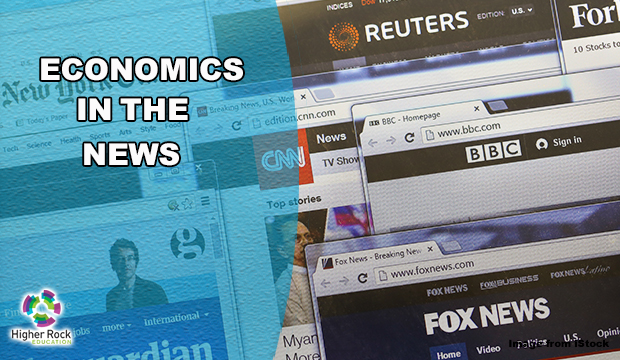Economics in the News – May 31-June 5, 2022
Economics impacts our lives every day. Below are some of the top storylines from this past week related to economics.
- Restaurants are finding creative ways to counter inflation. Rather than raising menu prices, more restaurants are passing along new fees and surcharges to their customers. Fees for a “noncash adjustment,” “fuel surcharge,” “kitchen appreciation,” or “temporary inflation fee” have been among the newest charges.
Experts say the wave of fees and charges is due to restaurants trying to keep up with inflation and a tight labor market. Restaurant owners have also been impacted by Mastercard and Visa raising their transaction fees for many merchants. Many customers often seem to be more willing to accept surcharges than outright price increases, and the surcharges are a way for restaurants to recoup some of their business costs for supplies. [The Wall Street Journal]
- Experts are warning that the nation’s power grid is under stress and increased outages could be likely as summer arrives and temperatures climb. Extreme weather advanced by climate change has accelerated the deterioration of the grid.
Energy experts warn that an unstable grid could set back plans to move rapidly toward a climate-friendlier economy. Relying on electric vehicles and plug-in home appliances such as stoves and water heaters will increase the demands placed on the power system. [The Washington Post]
- English Premier League club Chelsea Football Club recently sold for more than $3 billion. The Denver Broncos of the National Football League are projected to sell for more than $4 billion. The midmarket Portland Trail Blazers from the National Basketball Association has reportedly drawn an estimated offer of $2 billion from Nike founder Phil Knight.Values for sports teams continues to rise. Despite a war in Eastern Europe and inflation impacting western economies hindering customers’ savings, prospective owners willingly dole out the cash.
Part of the reasoning behind the rise in values for sports teams is due to the media rights deals. The large media deals that leagues sign with their media partners are examples of the value that media places on sports. Even tech companies such as Amazon and Apple are joining in the bidding wars. But there is a scarcity – there are only so many teams to go around – and there are more people able to afford the asking prices. In the United States, there are only 151 teams in the Big Five leagues – NFL, NBA, NHL, MLB and MLS. [The Athletic]
- The debate over remote work has intensified more than two years into the COVID-19 pandemic. Some managers are deciding to bring their employees back to the office, creating tension with their employees who want to continue working from home. Many Gen Z workers who started working during the pandemic have only known remote work. Many studies have found that working from home is feasible and beneficial. It has also created a shift in the balance of power between management and workers who threaten to walk away from their jobs.
Tesla CEO Elon Musk is among those who have made headlines by threatening Tesla employees to either work from the office or lose their jobs. Musk believes that Tesla employees better collaborate while in the office. Apple also wanted to bring back their employees three days a week, but postponed its plans following a petition from employees. [NPR]
- Amazon.com shares opened Monday’s trading session at $125.24 in its first trading session since a 20-for-1 stock split. It marks the first stock split for the e-commerce giant in more than two decades. Amazon is not the only major company to announce a stock split this year. Google parent company Alphabet announced a 20-for-1 split in February that will take place in July. Tesla announced in March that it intended for its second stock split since 2020, pending investor approval. Shopify also announced a 10-for-1 stock split in April.
Amazon’s stock split makes share price more attractive to retail investors, which was part of the reasoning behind Amazon’s decision to split its stock. Despite a 14 percent gain over the last two weeks, Amazon’s share price is down more than 10 percent since when the split was first announced in March. Amazon shares are down 25 percent for the year. [Bloomberg]
